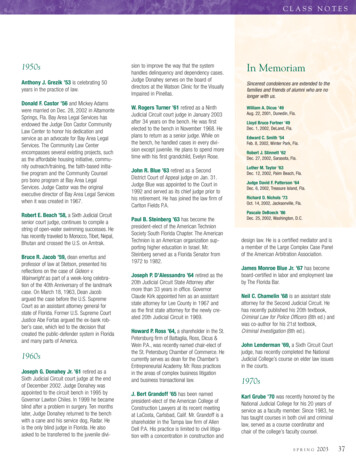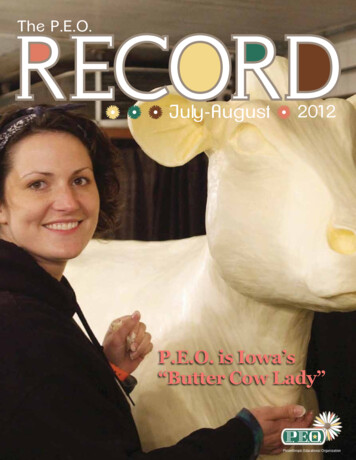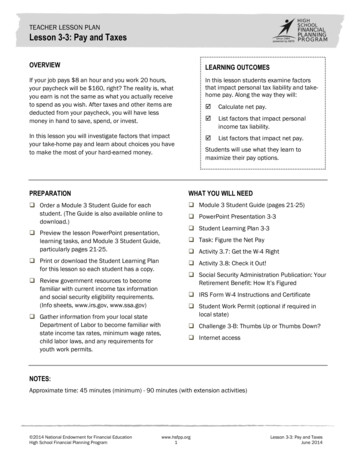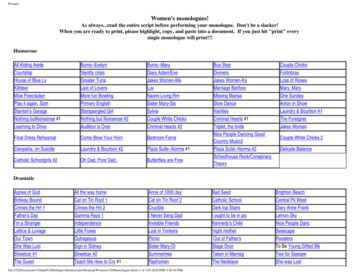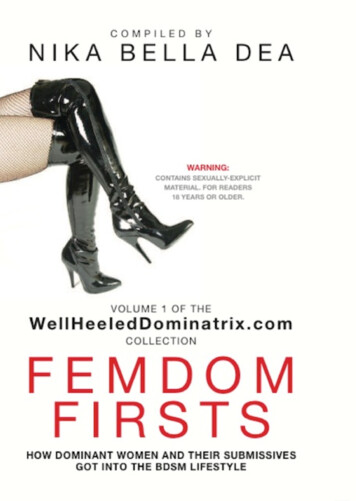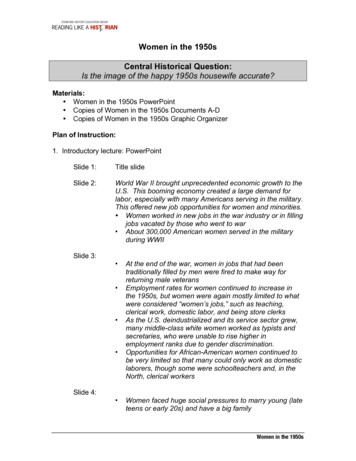
Transcription
Women in the 1950sCentral Historical Question:Is the image of the happy 1950s housewife accurate?Materials: Women in the 1950s PowerPoint Copies of Women in the 1950s Documents A-D Copies of Women in the 1950s Graphic OrganizerPlan of Instruction:1. Introductory lecture: PowerPointSlide 1:Title slideSlide 2:World War II brought unprecedented economic growth to theU.S. This booming economy created a large demand forlabor, especially with many Americans serving in the military.This offered new job opportunities for women and minorities. Women worked in new jobs in the war industry or in fillingjobs vacated by those who went to war About 300,000 American women served in the militaryduring WWIISlide 3: At the end of the war, women in jobs that had beentraditionally filled by men were fired to make way forreturning male veteransEmployment rates for women continued to increase inthe 1950s, but women were again mostly limited to whatwere considered “women’s jobs,” such as teaching,clerical work, domestic labor, and being store clerksAs the U.S. deindustrialized and its service sector grew,many middle-class white women worked as typists andsecretaries, who were unable to rise higher inemployment ranks due to gender discrimination.Opportunities for African-American women continued tobe very limited so that many could only work as domesticlaborers, though some were schoolteachers and, in theNorth, clerical workersSlide 4: Women faced huge social pressures to marry young (lateteens or early 20s) and have a big familyWomen in the 1950s
Women who could attend college were expected to goonly to find a husband, not a career pathWomen were pressured to be stay-at-home mothers iftheir families could afford it. Most minority families couldnot afford this.Single mothers were often shunnedCold War propaganda transmitted the idea that strongnuclear families would help the U.S. beat the USSR Slide 5:Not only were women marrying younger than before, theywere having babies right away and continued to for decades.From 1940 to 1960, the number of families with threechildren doubled and the number of families having a fourthchild quadrupled.Slide 6: The media portrayed domesticity as the ideal for womenTelevision shows and women’s magazines claimed thatwomen were most responsible for their children andhusband’s happiness and well-beingWomen were told to keep their houses and appearancesflawlessLeave it to Beaver: the white, nuclear family with specificgender roles domesticity: home or family lifeideal: what is considered most suitable or perfectSlide 7: Slide 8:The first mass-produced suburb, Levittown, New York,was built in 1951. These homes were affordable.Many returning veterans were able to buy a housebecause of the GI Bill—a law that said the federalgovernment would back loans to WWII veterans.The homes were built quickly and cheaply; massproduction resulted in uniformity of design andhomogenous suburban neighborhoods.Millions of African Americans moved out of the Southand into Northeastern, Midwestern, and Western citiesduring the Great Migration, causing “white flight” to thesuburbsLife in suburbia encouraged conformity; there was pressureto “keep up with the Joneses” with material purchases (e.g.,cars, appliances, etc.).Women in the 1950s
New forms of media, in particular, the television, promotedconsumer culture, with household products being stronglymarketed to women.2. Do Now: Look at these images (Slide 8) that were printed in popularmagazines in the 1950s. According to these images, what do you think lifewas like for suburban women in the 1950s?Share out responses.3. Transition: (Slide 9) Today, we are going to continue investigating thequestion of what was life like for suburban women in the 1950s, specifically:Is the image of the happy 1950s housewife accurate? Why or why not? Weare going to examine two rounds of documents in order to develop anhistorical claim.4. Round 1: Hand out Documents A and B. Students complete GraphicOrganizer in groups.5. Individually, students write hypothesis #1.6. Share out and discuss hypotheses.7. Round 2: Hand out Documents C and D. Students complete GraphicOrganizer in groups.8. Share out final hypotheses and evidence to back final claims.9. Discussion: Were housewives happy with their lives?Were women in the 1950s just staying at home?Documents A and B say women were staying at home; but Documents Cand D say that women were politically involved and even working. Whoshould we believe?Do you think African-American, Latina, Asian American, and women fromother minority groups had similar experiences to those depicted in thesedocuments?Women in the 1950s
Citations: Harry Henderson, “The Mass-Produced Suburbs: How PeopleLive in America’s Newest Towns.” Harper’s Weekly, November1953. http://harpers.org/archive/1953/11/0006495 BettyFriedan, The Feminine Mystique, 1963. Chapter 1.Joanne Meyerowitz, “Beyond the Feminine Mystique: AReassessment of Postwar Mass Culture, 1946-1958.”The Journal of American History, Vol. 79, No. 4 (Mar., 1993), pp.1455-1482. Alice Kessler-Harris, Out to Work, 2003, pp. 301302. Copyright 2009, Avishag Reisman and Bradley Fogo.Women in the 1950s
Document A: Harper’s Weekly, 1953 (Modified)The daily pattern of household life is governed by thehusband's commuting schedule. It is entirely a woman's daybecause virtually every male commutes. Usually the menmust leave between 7:00 and 8:00 A.M.; therefore they risebetween 6:00 and 7:00 A.M. In most cases the wife riseswith her husband, makes his breakfast while he shaves, andhas a cup of coffee with him. Then she often returns to beduntil the children get up. The husband is not likely to be backbefore 7:00 or 7:30 P.M.This leaves the woman alone all day to cope with the needsof the children, her house-keeping, and shopping. (Servants,needless to say, are unknown). When the husband returns,he is generally tired, both from his work and his traveling. . . .Often by the time the husband returns the children are readyfor bed. Then he and his wife eat their supper and wash thedishes. By 10:00 P.M. most lights are out.For the women this is a long, monotonous (boring) daily[routine]. Generally the men, once home, do not want toleave. They want to "relax" or "improve the property" -putteraround the lawn or shrubbery. However, the women want a"change." Thus, groups of women often go to the moviestogether.Source: Harry Henderson, “The Mass-Produced Suburbs:How People Live in America’s Newest Towns.” Harper’sWeekly, November 1953. Harry Henderson based hisobservations on extensive visits, observations, andinterviews in 1950s suburbs.Women in the 1950s
Document B: The Feminine Mystique by Betty Friedan(Modified)The problem . . . was a strange stirring, a sense ofdissatisfaction, a yearning that women suffered in the middleof the twentieth century in the United States. Each suburbanwife struggled with it alone. As she made the beds, shoppedfor groceries, matched slipcover material, ate peanut buttersandwiches with her children, . . . lay beside her husband atnight--she was afraid to ask even of herself the silentquestion--"Is this all?" . . .In the fifteen years after World War II, this mystique offeminine fulfillment became the cherished . . . core ofcontemporary American culture. Millions of women lived theirlives in the image of those pretty pictures of the Americansuburban housewife, kissing their husbands goodbye in frontof the picture window, depositing their station-wagons full ofchildren at school, and smiling as they ran the new electricwaxer over the spotless kitchen floor. They baked their ownbread, sewed their own and their children's clothes, kepttheir new washing machines and dryers running all day. . . .Their only dream was to be perfect wives and mothers; theirhighest ambition to have five children and a beautiful house,their only fight to get and keep their husbands. They had nothought for the unfeminine problems of the world outside thehome; they wanted the men to make the major decisions. . .Source: Betty Friedan was one of the early leaders of theWomen’s Rights movement that developed in the 1960s and1970s. She published The Feminine Mystique in 1963. In thebook, Friedan discusses how stifled and unsatisfied manysuburban women were in the 1950s.Women in the 1950s
Document C: Historian Joanne Meyerowitz (Modified)The Woman’s Home Companion (a popular women’smagazine) conducted opinion polls in 1947 and 1949 inwhich readers named the women they most admired. In bothyears the top four women were [women involved in politics].The postwar popular magazines were also positive aboutwomen’s participation in politics. The Ladies’ Home Journalhad numerous articles that supported women as political andcommunity leaders. One article in the Ladies’ Home Journalfrom 1947 encouraged women to “Make politics yourbusiness. Voting, office holding, raising your voice for newand better laws are just as important to your home and yourfamily as the evening meal or spring house cleaning.”[This shows that women at the time believed that individualachievement and public service were at least as importantas devotion to home and family].Source: Joanne Meyerowitz, “Beyond the FeminineMystique: A Reassessment of Postwar Mass Culture, 19461958.” The Journal of American History, Vol. 79, No. 4 (Mar.,1993), pp. 1455-1482. Meyerowitz examined 489 articles ineight monthly magazines from the 1950s.Women in the 1950s
Document D: Historian Alice Kessler-Harris (Modified)At first glance, the 1950s was a decade of the family. Butalready the family was flashing warning signals. . . . Homesand cars, refrigerators and washing machines, telephonesand multiple televisions required higher incomes . . . Thetwo-income family emerged. In 1950, wives earned wages inonly 21.6 percent of all families. By 1960, 30.5 percent ofwives worked for wages. And that figure would continue toincrease. Full- and part-time working wives contributed about26 percent of the total family income.Source: Alice Kessler-Harris, Out to Work, 2003, pp. 301302.Women in the 1950s
contemporary American culture. Millions of women lived their lives in the image of those pretty pictures of the American suburban housewife, kissing their husbands goodbye in front of the picture window, depositing their station-wagons full of children at school, and smiling as they ra
